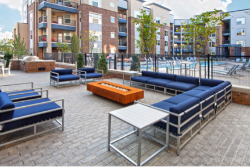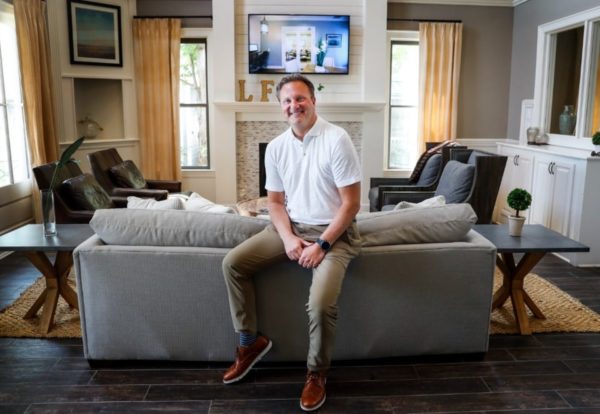This article and image were originally featured in The Daily Memphian.
Between the pandemic and a slew of interest rate hikes, the dream of home ownership is at best a hazy, someday hope for millions of people.
That has pressured multi-family homebuilders and managers to up their game in amenities and floorplans to suit not only longer-term renters but people who now may live several phases of their lives in the same unit or complex.
With rents up more than 17% nationally over this time last year, the most user-friendly amenities are add-ons that do not cost residents more.
“We’re offering more work-from-home options for residents than we ever have before,” said Brad Hill, chief investment officer for Germantown-based Mid-America Apartment Communities.
Some of the options include units with built-in desk or office areas. MAA is also building bigger clubhouses and refurbishing older ones to include individual workspace with WiFi printers for resident use.
“We have areas in there where we’ll have five or six or seven or eight individual offices that folks come in and use,” he said. “And then we’ll also have the big conference room as well for people who maybe have a team project or a team event.”
In some MAA complexes, the office space can be rented for short-term use. In others, it’s first-come, first served, he said.
“In some of our designs, we have multiple workspaces throughout the community, because, on Monday, you may want to work in an office,” he said. “On Tuesday, you may want to work at a desk overlooking a window and then on Day Three, you may want to be on the rooftop deck or something like that. You’ve got to have a lot of different options for the residents.”
At Legacy Farm in Collierville, besides a selection of work-from-home spaces around the property, Fogelman Properties added outdoor workout equipment.
It also upgraded the equipment in its rebranded “fitness barn” to give residents the level of technology they would get in upscale fitness centers.
“We’re very keen on quality and the advanced elements of fitness,” said David Nischwitz, senior vice president of redevelopment.
Fogelman has added cabanas around the pool that double as private workspaces when it’s not scorching hot.
Even before the pandemic, the quality of community building was central to resident retention. In the pandemic, the value of outdoor, community-building activity skyrocketed.
Interestingly, that got Fogelman looking at its tennis courts, once a necessity.
What it realized, Nischwitz said, is that people serious about tennis usually play at a club, leaving the high-visibility courts nearly empty.
“On another Collierville property, we took one court out and put in grill, overhead canopy and seating space on a new patio outside the pool. It’s very visible and extremely active,” he said.
“In some cases, where we have dual tennis courts, we’ll keep one as tennis,” he said. “If we have only one court, we’ll change it to hit a larger resident profile that would enjoy that space.”
Others, he said, will be turned into dog parks or play spaces for different kinds of games, including pickleball.
Dog parks are the No. 1 amenity across Fogelman Properties.
“Many of our residents have pets,” Nischwitz said. “It’s 70% to 80%; it’s not 20%. If they are in the dog park, their dogs do not have to be leashed.”
In the Southeast, the multifamily business is booming, partly due to the influx from other regions.
“Our properties are experiencing a large ‘in-migration’ effect,” said Mark Fogelman, president of Fogelman Properties, “as portions of the population left the higher-density and more expensive Northeast and West Coast and sought a new life here.
“We are seeing this ‘in-migration’ effect across all of our markets, even in Memphis, where we are seeing residents move from thousands of miles away.”
Remote work also plays a major role in the phenomena, he said.
Recent research by RealPage Inc. found that more than 57% of tenants in market-rate units chose to renew their leases in the past year compared to 51% between 2010 and 2019. Even though rent nationally has risen by double-digits percentages, it is often still less expensive than a down payment on a house and a mortgage.
The median monthly rent in Memphis for a two-bedroom apartment is $1,127, up 28% since March 2020, according to ApartmentList data.
“This retention rate of residents has been increasing for the last couple of years,” Hill said. “And if you look at our region of the country, the top reason folks leave us is for a job transfer. They are definitely down in our region because the job growth here has been very strong.
“The demand for housing in our area of the country is really due to this strong employment market, and also the rising cost of buying a home.”
Resident retention rates are part of an overall picture that includes housing supply, the cost of owning but also intangibles like people marrying and beginning families later in life, delaying the need for more space.
“All of these trends were taking place well before the pandemic and higher interest rates hit, which have only further propelled apartment demand,” Fogelman said.
“Our biggest challenge continues to be the labor market,” he said. “Fortunately, our stability and size have provided many with excellent career opportunities.”
The people most locked out of the housing market are Millennials — those born between early 1980s and late 1990s. According to recent Census data, 48.6% of them own homes, more than 20 percentage points lower than the next older generation and nearly 30 percentage points lower than Baby Boomers.
Even when adjusted for age, Millennials show less home ownership. Among those who are 40, at the top of the age bracket, 60% own homes. At the same point in life, 64% of Generation X, 68 % of Baby Boomers and 73% of those who are Silents, over 76 years old, owned homes, according to ApartmentList.
Every year, a larger share of Millennial renters say they will never own a home. The pandemic increased the frequency. In 2021, 22% said they would “always be renters.” Early data from 2022 suggests the share is increasing.
Though it doesn’t make sense for everyone, Parker Sitton, vice president of real estate for Six Land, is hoping to build 105 micro lofts at 442 Madison. Each unit would average 423 square feet and rent in the neighborhood of $1,200 to $1,400.
The price includes furniture, utilities and WiFi. The complex would have almost no amenities, except perhaps a coffee bar in the leasing office.
In Jonesboro, Arkansas, where Six Land built a similar concept, Sitton said he expected the tenants would be largely students.
“What I noticed is that it was only about 50% students; the rest were working professionals but not just young people.
“I have people in their 60s, choosing to live in downtown Jonesboro in our concept,” he said.
Most of them have permanent homes outside of Jonesboro but want a place in town for work or pleasure, he said.
Six Land is seeking a PILOT from the Center City Revenue Finance Corp. If approved, construction would begin in early 2023.
“When apartments became institutionalized really professionalized, it was all about cable TV and air-conditioning,” said Jimmy Ringel, chief operating officer at Makowsky Ringel Greenberg, based here.
“Then it was fitness rooms and yoga and outdoor kitchens and things like that. There is always a new trend. What you want to do is address the things that are longstanding and not fads.”
He expects the next upgrade with lasting appeal will be high-grade, smart technology.
“Think of what you see when you go to a really nice hotel. Obviously, the internet has to be really strong for these systems to work,” Ringel said.
“Those systems can be expensive as an upfront cost. Over a long period of time, they pay off because they reduce operating expenses.
“And those gadgets can be really cool for residents.”

